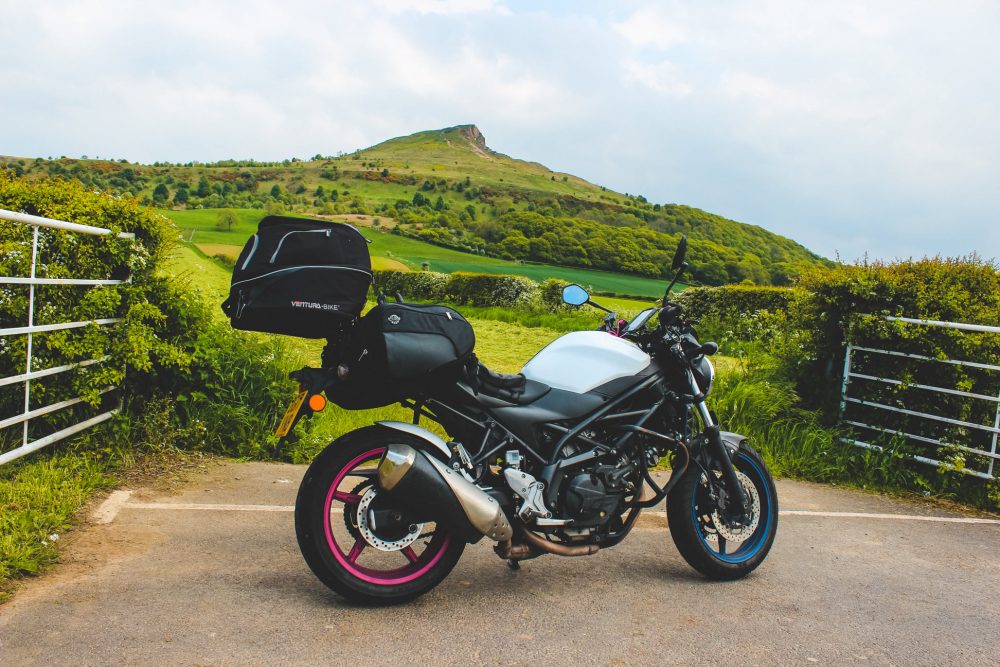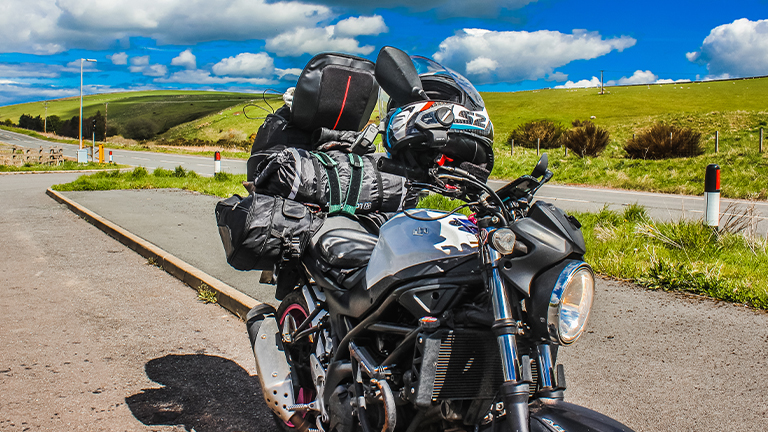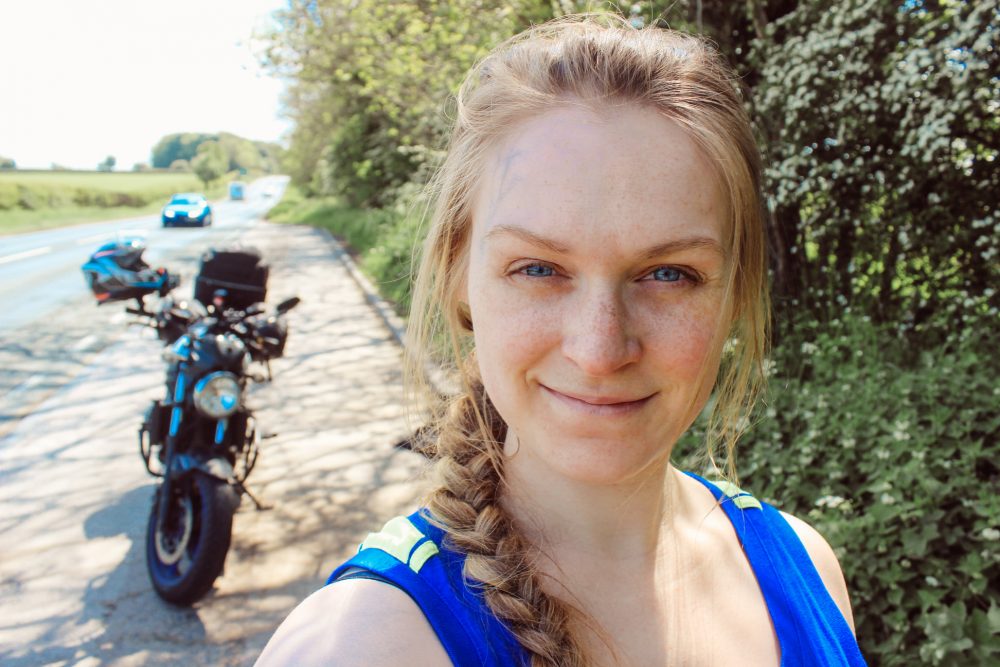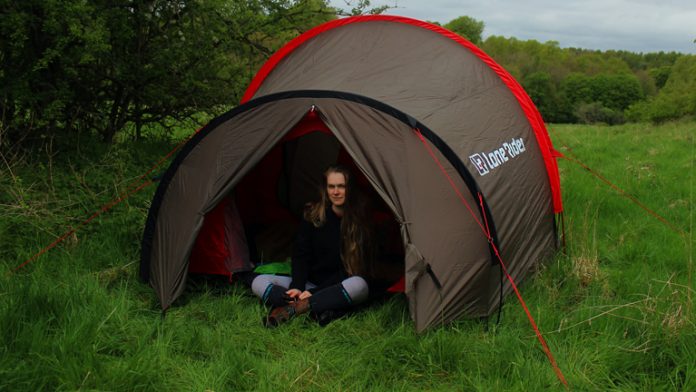Do you love camping? Do you like motorcycles? Why not combine the two! Motorcycle camping is an excellent way to get out in nature, have some fun and see a different side of the world. This guide will help demystify your first motorcycle camping experience by answering all those questions about what to take and how to pack.
The topics we’re going to discuss:
- How much luggage should I take?
- What should I pack for motorcycle camping?
- Packing tips and tricks.
- Should I travel alone?
- Do you think motorcycle camping is for me, too?
How much luggage should I take?
When it comes to bike touring, it’s essential to get the balance right between packing too much gear and simply being unprepared. My first bike trip involved an 800 mile trip to Scotland, and I found myself at both ends of the extremes. I had packed too many unnecessary items and not enough of the essentials. However, don’t be surprised if you find yourself in the same position. When it comes to packing your travels, it can take a few attempts to narrow down the right amount of luggage – and unfortunately, it’s usually experience that teaches us the best way forward.
Luckily, the motorcycle camping checklist is an excellent place to start. Of course, the most crucial factor will be your gear and supplies for the bike itself, which are plentiful on this list. Beyond that, it’s worth considering what you’ll need for food-preparing (a cool bag), cooking utensils (pots & pans), and sleeping arrangements.
The first thing you’ll want to decide is “how long am I going for?” If it’s just a weekend away, or even as little as a one-night camping trip, then you can pack light. But if your destination will require more time than that, you’ll need to give some serious consideration to what you need to pack.

Motorcycle camping checklist
What do I take?
- Tent or a Canopy (or both)
- Sleeping Bag, Pillow or roll matt
- Cooking supplies, utensils such as knives, forks, and spoons, and of course food
- Change of clothes
- A way to charge your gadgets or technology
- A map in case your GPS / phone breaks
- A hand-written copy of emergency phone numbers and addresses
- A small amount of cash
The Tent
Now preparing for motorcycle camping may leave you thinking, what kind of tent should I buy? Well, my personal favourite is the LoneRider Adventure Motorcycle Touring Tent. This is a vast tent, complete with a motorcycle garage but great for when you need to work on your bike in adverse weather conditions. Now I won’t lie, this tent isn’t cheap, and it may not be something you purchase straight off the bat. However, if you’re considering getting serious about your travels, investing in a decent tent like the LoneRider will be worthwhile. Click here to view the LoneRider Adventure Motorcycle Tent.
The Sleeping Bag
For the sleeping bag, I would recommend taking a sac-down style rather than an inflatable one. It would be best if you also considered the weather conditions you’re going to be sleeping in. Are you going to be sleeping in a hot, humid climate, typical cold British rain, or perhaps even the Norwegian snow? Your choice of sleeping bag should reflect the environment you’ll be staying in. Some people opt to purchase one all-season sleeping bag, whereas others may prefer to invest a bit more and buy several sleeping bags for different seasons and pack as needed. Whatever you chose to do, it’s essential to do your research about the area you’ll be sleeping in and what kind of temperatures and humidity you’ll need to prepare yourself for.
- Budget Bag: Terra Hiker Down Sleeping Bag
- Mid-range: Mountain Warehouse Extreme Lightweight Down Sleeping Bag
- High-end: Rab Ascent 700 Mummy Sleeping Bag
Roll Mat
A lot of people may view this as unnecessary. However, I strongly advise packing a roll mat. The one that I used is
- Budget Mat: Multi-Purpose Roll Mat
- Mid-range: Inflatable Airbed Roll Mat
- High-end: Therm-a-Rest ProLite Apex
The mat that I use is the RUNACC Self-Inflating Camping Sleeping Pad.
Having a roll mat bridges the gap between your body heat and the ground, ensuring that you stay warmer overnight. Unfortunately, I didn’t take a roll mat on my first camping trip, and as a result, it was a horrific experience. I was constantly cold throughout the night and ended up packing up and heading home early.
This particular roll matt that I’ve recommended folds up extremely small and lightweight and has a built-in pump allowing you to have an airbed experience.
Cooking equipment
When it comes to eating on the road. You have a few decisions. You have two options: invest in some cooking equipment and take your food, or you can eat on the road at various outlets and restaurants. There’s a whole combination of different cooking options you can take. I recommend one of the following
- Jetboil
- FastBoil
- Mini Gas cooker
I use a FastBoil which I found on eBay for a fraction of the cost of a Jetboil. The camping gas you purchase on Amazon here or go to your local camping store. I found that camping stores tend to be a little bit cheaper than Amazon for this particular item.
You’ll, of course, need some basic cooking supplies such as a knife, a fork, spoon. Something to eat out of (mess pans are usually rather popular). A mug/cup for drinks.
The best kinds of cooking supplies are made from aluminium. They’re light, they conduct heat well, and are durable too.
Change of clothes
Layers of clothes. If you’re lucky, the weather will be fantastic during your entire camping experience – but realistically, it’s not common. You should plan for a range of temperatures. You can do this by packing clothing that can be layered on or taken off accordingly. It is also crucial to take some warmer items if expecting cold/wind.

External USB batteries
If you’re as tech-heavy as me, then chances are you’ll need a way to charge your gadgets. When it comes to external batteries for touring, I usually recommend at least 50000mah. In addition to an external battery, I also fitted a USB port to my motorcycle to help charge my Phone/GoPro/Sena Headset during use. When I had fully charged my gadgets, I’d flip the USB to feed into an external battery to fill up for later use at the campsite.
I wouldn’t recommend getting one with a built-in solar panel. It’s far cheaper to fit a simple USB port to your handlebars and charge as you go. You can also get additional extras on your batteries, such as wireless charging or a torch. I’d suggest you avoid one with a torch- you don’t want to be walking around with an expensive battery in the middle of the night and intentionally drop and break it. However, wireless charging can be a good extra if you’re phone supports it. This is because when riding in wet weather conditions, it may be the case that your phone charging port does get damp, and you’re unable to charge it whilst it’s drying out.
A few good external batteries
Torch
It’s good practice to pack a torch when camping for use off the bike, especially if you’re wild camping. A typical torch will last for about 50 hours on a set of batteries which you can get for less than £20. They’re also handy to have when changing your tire at night or if there’s an accident and the emergency services need to see what they are doing.
Basic First Aid Kit
Basic things like band-aids, topical solutions for minor cuts/scrapes are a must – but also include more heavy items such as eye drops and antihistamines in case of allergic reactions or insect bites. Consider other medications you might need (such as asthma.)
Sena Headset
This one is optional, but I recommend the Sena 50s. It’s a Bluetooth headset for your motorcycle, which will allow you to make and receive phone calls and hear music stored on the device.
Click here to view the Sena50s on Amazon.
GPS Tracker
This is an optional item, but if you are travelling in remote areas or going wild camping, it may be worth investing in one of these devices so that someone can find you if something goes wrong. Another good option is to install the app “What3Squares” – it’s a device that quickly allows emergency operators to locate you in the worst-case scenario.
Packing tips and tricks
When it comes to packing your bags, you want to arrange your luggage in a useable manner. First, consider the order that you will use items throughout the day. For example, the tent is usually the first thing you deal with when you stop. I place my LoneRider tent on my seat to undo my straps start building it without needing to undo any luggage.
However, when the tent is loaded on my bike, I cannot access the side panniers. For this reason, I often store my sleeping mat, roll matt, which will be used for sleeping at night, in my side panniers. For items that I tend to use throughout the day, such as my SLR or my film equipment, I often tend to take in the backbox. This means that I can quickly often my bag without the need to re-arrange anything.
The side panniers will store most of my spare clothes. However, I’ll always keep a spare pair of clothes easy to reach in the backbox in case of sudden adverse weather. This goes the same for extra bike clothes and socks.
Should I travel alone?
Although travelling alone can seem very daunting, it does come with many great benefits. I prefer travelling alone; it means that I can set my own pace while riding throughout the day. I can stop when I want and continue when I want. Want to take a new route? No issues. You’re entirely free to dictate where you want to go.
In addition to this, when it comes to biking, you’re never truly alone. It’s a commonplace for bikers to naturally gravitate towards each other at campsites, petrol stations, and even roadside cafes. However, even if you prefer to travel alone, you still can socialize from time to time.
However, not everyone enjoys travelling by themselves. If this is the case, there’s nothing wrong with travelling in a group. This can be done by using multiple motorcycles or choosing to travel on someone else’s motorcycle.
Whatever you choose, remember it’s bout making the journey your own. Whoever you decide to go with, it’ll undoubtedly be an adventure worth remembering for many years to come!

Benefits of Camping with a Motorcycle:
Camping is so much more than pitching a tent and sleeping outside. It’s about the freedom to go anywhere in any conditions, meeting new people on every journey, experiencing rural life firsthand without having to sacrifice your comfort levels or safety and being able to enjoy nature at its best.
You can’t beat the thrill of waking up in a fantastic location, with nothing but nature and your motorcycle as your company as you head off to explore a new place each day.
Camping is about more than spending time outdoors- it’s also about meeting people from around the world, experiencing new sights and cultures.
Do you think motorcycle camping is for me, too?
Motorcycle camping is for anyone who loves the open road and wants to explore new places. Not everyone enjoys camping. It can be not easy to get into. Most people don’t want to crawl into a wet, cold tent after a long day of riding in the rain.
Some people don’t want to sleep on the ground. And if you are used to a soft bed, it can be not easy to make do with sleeping pads and blankets when in nature.
But no matter who you are or what your preferences may be, there’s a motorcycle camping setup for you. The right gear will ensure that you can be as comfortable as possible whilst battling the elements.
An excellent place to start if you’re not sure whether or not motorcycle camping is for you, consider going on a short weekend bike trip with friends.
From here, you’ll get a better understanding of whether it’s the right kind of hobby for you.
View my Youtube Video
SaffySprocket.com a participant in the Amazon Services LLC Associates Program, an affiliate advertising program designed to provide a means for sites to earn advertising fees by advertising and linking to Amazon.com.



